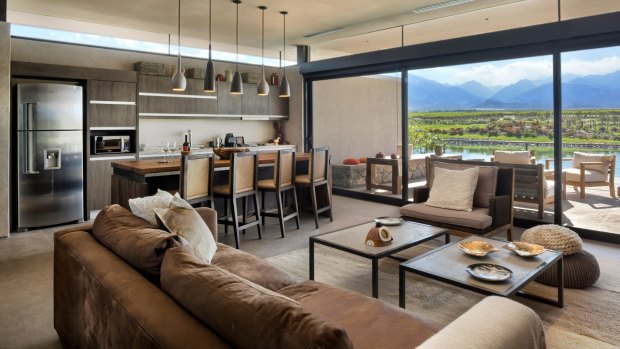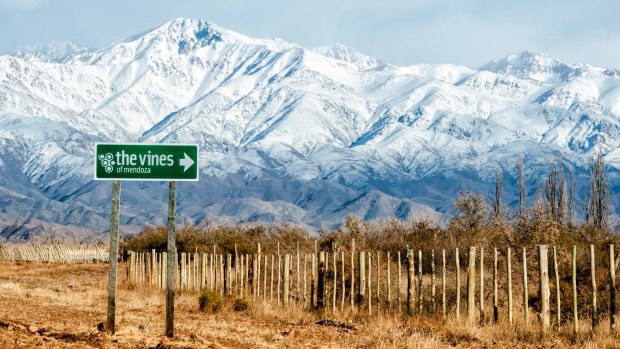This was published 4 years ago
Mendoza, Argentina: Cooking class and wine making experience at Bodega Monteviejo winery
By Tatyana Leonov

The Vines Resort & Spa.
The two desserts side by side look vastly different. Chef Nadia Haron's handiwork is a work of art that would look great on a food magazine cover, while my version is a little less refined. It's the spun toffee nest that sets us apart the most. Nadia demonstrates how to spin delicate fibres from the molten caramel, crafting a beautifully proportioned nest from the hair-fine strands. My creation, well it's a mess of a nest.
My husband and I have already prepared Peruvian potato stacks and gnocchi and I can confidently say that those efforts were more successful, from a visual stance. And from a taste standpoint, too. We skipped breakfast knowing we would be spending a chunk of the day learning to cook and eating our efforts and drinking plenty of wine en route.
A cooking class with Haron, an eminent Argentinian chef, is one of the boutique experiences available to Abercrombie & Kent guests while in Mendoza, and takes place at Bodega Monteviejo winery in Clos de los Siete, a wine empire that's renowned globally in wine circles.

Vineyards below the Andes.
Although wine has been produced in the region since the mid-16th century. Our guide Mariana, who also happens to be a sommelier, explains that missionaries who owned land became accidental winemakers. "Grapes were planted and they knew that if they left grape juice out it transformed into something different," she says.
As the cities of Buenos Aires and Cordoba flourished, winemakers in Mendoza sent their wines there. Then in the late 1800s and early 19th century immigrants, predominantly from Spain and Italy, moved to Mendoza bringing knowledge and new technology such as pumps and presses. "It was a prosperous time for Argentinian domestic wine production," says Mariana.
When the cooking class finishes Bodega Monteviejo's hospitality manager, Diego, glides over with the lunch and wine menu. Although we've been snacking on our creations and sipping wine since late morning, clearly the culinary journey must go on.
As we peruse the options Diego explains that although the food is a highlight, it's the wine that takes centrestage. We order onion soup topped with parmesan foam and share a tender rib-eye served with ratatouille. Wines are matched with our courses: Petite Fleur Chardonnay 2017 with the soup and Lindaflor Blend 2012 with our main. Everything is perfect and it's easy to forget that gourmet experiences such as this one are relatively new to Mendoza.
"People were drinking beer and Coke in the 1960s and 1970s," Mariana tells us. "Wine was taking a back seat."
The industry overhaul that began in the 1980s is the reason I and the other international tourists are here. New ideas and processes were implemented when experts from countries such as France and the USA came to share their knowledge. Wines started tasting good and people began talking about it.
"Then everyone discovered malbec," Mariana says. "Although it's French it finds the perfect conditions to develop in Mendoza."
The three main areas for Mendoza's wine production are Maipu Valley, Lujan de Cuyo and Uco Valley, and although Uco Valley is the farthest from the city of Mendoza it's where we spend our two days. We dedicate a whole day to Clos de los Siete and visit two out of the four wineries spread out on close to 809 hectares of vineyards. The concept of multiple wineries on one estate was championed by famous French winemaker Michel Rolland.
The wineries are their own entities and all create premium wines using mainly traditional French methods. Each year they collectively produce one Clos de los Siete branded wine, which is always one (big) part malbec with the addition of other varieties.
Sommelier Bruno shows us around the boutique Bodega Rolland and tells us that Rolland comes to Bodega Rolland four times a year and that his visits concentrate on tastings. He says each barrel is only used once to achieve optimum taste (used barrels are sold to other wineries). One of the wines we sample is the Mariflor Camille 2009, an intense but easy-to-drink drop that Rolland named in honour of his granddaughter. Other wines are named after his other grandchildren.
After a day of being wined and dined our accommodation, The Vines Resort & Spa, calls. It appears even more mesmerising than it did when we arrived, which could have something to do with the time of day. The luxury resort sits among 400 hectares of vineyards, and now, with the sun setting, the sky turns a fiery orange and the snow-capped Andes in the distance gleam purple-pink.
It's perfect timing for a glass of wine and the sommelier brings out a selection of his five current favourites, with only one malbec in sight.
The resort's Private Vineyards is comprised of more than 200 smaller plots that belong to owners from 18 different countries. Each owner manages their plot in collaboration with the Vines team. Some owners are hands-on and participate in decisions about how the grapes are grown, treated, picked, barrelled and corked. Others sit back and receive wines from their own vineyard with their own name, delivered to their front door.
Costs for owners include land ownership, a yearly maintenance fee and production –bottling, cork ageing and labelling. If I had a spare half a million dollars I'd happily join the club.
Nevertheless, it's easy to fantasise in a destination as picturesque as this one. We float back to our lavish room and sink into the sofas where we enjoy one last glass for today. When I pour the wine I playfully sound out the words, "Leonov wine"… it has a lovely ring to it, I think.
FIVE OUTDOOR ACTIVITIES IN MENDOZA
GO FOR A SPIN
Bicycling among vineyards is popular in many wine regions around the world thanks to mainly flat trails and scenic vineyard views. In Mendoza there are tours available and self-guided routes. Most end up at a winery or three.
GAUCHO HORSERIDE
A horseride here offers a glimpse into Argentina's gaucho culture. Vineyard rides are available for those who can't keep away from the wine aspect, but the sunrise and sunset journeys to and around the base of the Andes are spectacular. Rug up.
HIKE HEAVEN
There are plenty of hiking trails around the region, with the partial ascent of Mount Aconcagua – the tallest mountain in South America – popular with climbers. The hike to Cerro Arco is another great option. It's close to Mendoza city and the ascent is manageable for most.
WHITE-WATER RAFTING
The Mendoza River not only irrigates the region's grape-growing valleys, it also provides hours of fun in the form of rapids to manoeuver as you're funnelled downstream.
GET HIGH
Mendoza is well-known for paragliding, with a number of tour operators offering to take customers sky high. Seeing the Andes and vineyards from above offers a new perspective.
TRIP NOTES
Tatyana Leonov travelled as a guest of Abercrombie & Kent.
MORE
STAY
The Vines Resort & Spa is a lavish 21-villa property with views of the Andes. Guests can participate in various winemaking activities such as harvesting grapes and bottling wine.See vinesresortandspa.com
FLY
Air New Zealand flies to Buenos Aires from Australia via Auckland three times a week with connections to Mendoza available on partner airline Aerolineas Argentinas. See airnewzealand.com.au
TOUR
The Mendoza experience is part of Abercrombie & Kent's15-day Treasures of Argentina private journey, which includes luxury accommodation, some meals, expert guides and transport including domestic flights. See abercrombiekent.com.au
Sign up for the Traveller Deals newsletter
Get exclusive travel deals delivered straight to your inbox. Sign up now.